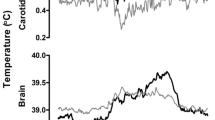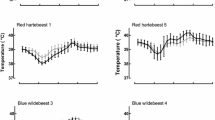Abstract
Panting is a mechanism that increases respiratory evaporative heat loss (REHL) under heat load. Because REHL uses body water, it is physiologically and ecologically relevant to know under what conditions free-ranging animals use panting. We investigated whether the cranial arterio-venous temperature difference could provide information about REHL. We exposed sheep to environments varying in ambient dry bulb temperatures (Env 1: ~15°C, Env 2: ~25°C, Env 3: ~40°C, Env 4: ~40°C + infrared radiation) and measured REHL simultaneously with carotid arterial (T car) and jugular venous (T jug) blood temperatures, as well as brain (T brain) and rectal (T rec) temperatures. REHL increased significantly with ambient temperature, from 18.4 ± 4.5 W at Env 1 to 79.5 ± 12.6 W at Env 4 (P < 10−6). While there was no effect of environment on T car (P = 0.7) or T jug (P = 0.09), the difference between them (T a-v = T car − T jug) increased from Env 1 to Env 2 (P = 0.04) and from Env 3 to Env 4 (P = 0.008). T a-v reached a maximum of 0.7 ± 0.2°C at Env 4 and was positively correlated with REHL across environments (r 2 = 0.78, F = 34.7, P < 10−3). Calculated cranial blood flow changed only from Env 2 to Env 3 (P = 0.002). The increase in REHL maintained homeothermy when dry heat loss decreased. While REHL could increase without generating an increase in T a-v, any increase in T a-v was always associated with an increase in REHL. We conclude that the cranial T a-v provides useful information about REHL in panting animals.






Similar content being viewed by others
References
Barenbrug AWT (1974) Psychrometry and psychrometric charts. Chamber of Mines, Cape Town, South Africa
Blache D, Fabre-Nys C, Venier G (1991) Ventromedian hypothalamus as a target for oestradiol action on proceptivity, receptivity and LH surge of the ewe. Brain Res 546:241–249
Blache D, Batailler M, Fabre-Nys C (1994) Oestrogen receptors in the preoptico hypothalamic continuum: immunohistochemical study of the distribution and cell density during oestrous cycle in ovariectomized ewe. J Neuroendocrinol 6:329–339
Blake AST, Petley GW, Deakin CD (2000) Effects of changes in packed cell volume on the specific heat capacity of blood: implications for studies measuring heat exchange in extracorporeal circuits. Br J Anaesth 84:28–32
Bligh J (1963) The receptors concerned in the respiratory response to humidity in sheep at high ambient temperature. J Physiol 168:747–763
Fabre-Nys C, Blache D, Lavenet C (1991) A method for accurate implantation in the sheep brain. In: Greenstein BD (ed) Neuroendocrine research methods: implantation and transfection procedures. Harwood Academic Publishers, Chur, pp 295–314
Findlay JD (1957) The respiratory activity of calves subjected to thermal stress. J Physiol 136:300–309
Findlay JD, Ingram DL (1961) Brain temperature as a factor in the control of thermal polypnea in the ox (Bos taurus). J Physiol 155:72–85
Fuller A, Moss DG, Skinner JD, Jessen PT, Mitchell G, Mitchell D (1999) Brain, abdominal, and arterial blood temperatures of free-ranging eland in their natural habitat. Pflugers Arch 438:671–680
Fuller A, Kamerman PR, Maloney SK, Matthee A, Mitchell G, Mitchell D (2005) A year in the thermal life of a free-ranging herd of springbok Antidorcas marsupialis. J Exp Biol 208:2855–2864
Gauly M, Kraus M, Vervelde L, van Leeuwen MAW, Erhardta G (2002) Estimating genetic differences in natural resistance in Rhon and Merinoland sheep following experimental Haemonchus contortus infection. Vet Parasit 106:55–67
Hales JRS (1969) Changes in respiratory activity and body temperature of the severely heat-stressed ox and sheep. Comp Biochem Physiol 31:975–985
Hales JRS (1973a) Effects of exposure to hot environments on the regional distribution of blood flow and on cardiorespiratory function in sheep. Pflugers Arch 344:133–148
Hales JRS (1973b) Effects of heat stress on blood flow in respiratory and non-respiratory muscles in the sheep. Pflugers Arch 345:123–130
Hales JRS (1973c) Effects of exposure to hot environments on total and regional blood flow in the brain and spinal cord of the sheep. Pflugers Arch 344:327–337
Hales JRS, Brown GD (1974) Net energetic and thermoregulatory efficiency during panting in the sheep. Comp Biochem Physiol A 49:413–422
Hales JRS, Webster MED (1967) Respiratory function during thermal tachypnoea in sheep. J Physiol 190:241–260
Hales JRS, Bennett JW, Fawcett AA (1977) Integrated changes in regional circulatory activity evoked by thermal stimulation of the hypothalamus. Pflugers Arch 372:157–164
Hetem RS, Maloney SK, Fuller A, Meyer LCR, Mitchell D (2007) Validation of a biotelemetric technique, using ambulatory miniature black globe thermometers, to quantify thermoregulatory behaviour in ungulates. J Exp Zool A 307:342–356
Hinghofer-Szalkay HG, Greenleaf JE (1987) Continuous monitoring of blood volume changes in humans. J Appl Physiol 63:1003–1007
Ingram DL, Legge KF (1971) The influence of deep body temperatures and skin temperatures on peripheral blood flow in the pig. J Physiol 215:693–707
IUPS Thermal Commission (2001) Glossary of terms for thermal physiology: third edition. Jpn J Physiol 51:245–280
Jessen C (1977) Interaction of air temperature and core temperatures in thermoregulation of the goat. J Physiol 264:585–606
Johnsen HK, Folkow LP (1988) Vascular control of brain cooling in reindeer. Am J Physiol 254:R730–R739
Kronert H, Pleschka K (1976) Lingual blood flow and its hypothalamic control in the dog during panting. Pflugers Arch 367:25–31
Kuhnen G (1997) Selective brain cooling reduces respiratory water loss during heat stress. Comp Biochem Physiol A 118:891–895
Lee DHK (1950) Studies of heat regulation in the sheep, with special reference to the Merino. Aust J Agric Res 1:200–216
Lust A, Fuller A, Maloney SK, Mitchell D, Mitchell G (2007) Thermoregulation in pronghorn antelope (Antilocapra americana Ord) in the summer. J Exp Biol 210:2444–2452
Maloney SK, Fuller A, Mitchell G, Mitchell D (2001) Rectal temperature measurement results in artifactual evidence of selective brain cooling. Am J Physiol Regul Integr Comp Physiol 281:R108–R114
Maloney SK, Fuller A, Mitchell G, Mitchell D (2002) Brain and arterial blood temperatures of free-ranging oryx (Oryx gazella). Pflugers Arch 443:437–445
Maloney SK, Mitchell D, Blache D (2007) The contribution of carotid rete variability to brain temperature variability in sheep in a thermoneutral environment. Am J Physiol Regul Integr Comp Physiol 292:R1298–R1305
Mitchell D, Maloney SK, Jessen C, Laburn HP, Kamerman PR, Mitchell G, Fuller A (2002) Adaptive heterothermy and selective brain cooling in arid-zone mammals. Comp Biochem Physiol B Biochem Mol Biol 131:571–585
Murrish DE (1973) Respiratory heat and water exchange in penguins. Respir Physiol 19:262–270
Neimark MA, Konstas AA, Laine AF, Pile-Spellman J (2007) Integration of jugular venous return and circle of Willis in a theoretical human model of selective brain cooling. J Appl Physiol 103:1837–1847
Nelson DA, Nunneley SA (1998) Brain temperature and limits on transcranial cooling humans: quantitative modelling results. Eur J Appl Physiol 78:353–359
Nybo L, Secher NH, Nielsen B (2002) Inadequate heat release from the human brain during prolonged exercise with hyperthermia. J Physiol 545:697–704
Pleschka K, Kuhn P, Nagai M (1979) Differential vasomotor adjustments in the evaporative tissues of the tongue and nose in the dog under heat load. Pflugers Arch 382:255–262
Richard P (1967) Atlas stereotaxique du cerveau de Brebis. I.N.R.A., Paris
Robertshaw D (1968) The pattern and control of sweating in the sheep and the goat. J Physiol 198:531–539
Schmidt-Nielsen K (1997) Animal physiology: adaptation and environment. Cambridge University press, Cambridge
Schmidt-Nielsen K, Hainsworth FR, Murrish DE (1970) Counter-current heat exchange in the respiratory passages: effect on water and heat balance. Respir Physiol 9:263–276
Weast RC, Astle MJ (1981–1982) CRC handbook of chemistry and physics, 62nd edn. CRC Press Inc, Florida, USA
Acknowledgments
This project was funded by an Australian Research Council Discovery Project Grant (DP0345058) to SKM and DB. All procedures were approved by the Animal Ethics Committee of the University of Western Australia (approval RA 3/100/088). The authors wish to thank the staff at the Large Animal Facility and Margaret Blackberry and Kristin Hunt for their valuable technical assistance with the research.
Author information
Authors and Affiliations
Corresponding author
Additional information
Communicated by I. D. Hume.
Rights and permissions
About this article
Cite this article
Vesterdorf, K., Blache, D. & Maloney, S.K. The cranial arterio-venous temperature difference is related to respiratory evaporative heat loss in a panting species, the sheep (Ovis aries). J Comp Physiol B 181, 277–288 (2011). https://doi.org/10.1007/s00360-010-0513-7
Received:
Revised:
Accepted:
Published:
Issue Date:
DOI: https://doi.org/10.1007/s00360-010-0513-7




